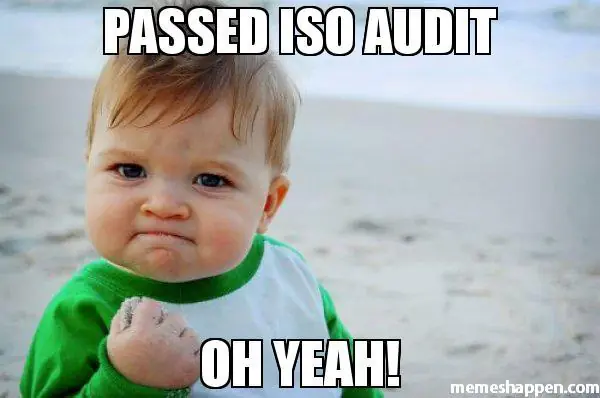
2024-2-7 14:8:50 Author: securityboulevard.com(查看原文) 阅读量:5 收藏
ISO-what now? Navigating ISO 27001 is tricky (to say the least), and it can easily feel like trying to understand a foreign language – complete with its own vocabulary and terminology. Fortunately, you’ve got friends in the industry to show you the ropes and guide you through the certification process one step at a time.
But first, let’s start with the basics.
What is an ISO 27001 Certification Exactly?
Your business deals with data (and lots of it), and an information security standard is no longer seen as a novelty but a basic necessity of modern-day business. That’s where ISO 27001 comes in – the leading information security standard created by the International Organization for Standardization (ISO).
Not only does obtaining an ISO certification give your customers rest assurance in your security posture, but it also provides your business with the necessary framework and guidelines to establish and implement an information security management system (ISMS).
Okay, we get it – that can sound like a tech talk. So, let’s break it down to basics in true Scytale fashion.
Understanding ISO 27001: Key Concepts and Terminology
Are you a newbie to the ISO 27001 certification process? No worries. Once you’ve got the key concepts and terminology down, you’ll feel (and talk) like a compliance guru.
Here’s what you need to know to start your journey towards an ISO 27001 certification.
What is an ISMS?
An Information Security Management System (ISMS) is essentially everything your organization does to protect information assets. This includes the policies, processes and procedures set in place to help an organization identify, analyze and manage security risks. Essentially, it’s the root cause of all things ISO 27001 – to establish and manage a robust ISMS containing all the relevant and required controls to ensure confidentiality, integrity, and availability of data.
ISO 27001 Controls
‘Controls’ are frequently mentioned in the ISO 27001 readiness and certification process, and rightly so. If ISO 27001 is your framework, your controls are the pillars and foundation keeping everything firm, steady and shake-proof. ISO 27001 encompasses a set of 114 comprehensive controls across 14 different domains consisting of the ISMS and Annex A controls. It’s important to note that these controls are adaptable, allowing organizations to apply them according to their specific risk environment and business requirements. In brief, controls refer to the specific processes and policies that must be put in place in order for organizations to successfully mitigate information security risks.
What is an ISO 27001 Internal Audit?
Before jumping down the rabbit hole of that which is the ISO 27001 security standard, let’s look at some of the concepts that are most applicable to where you are now – the very beginning.
An ISO 27001 internal audit is a crucial part of the ISO 27001 process and is an in-depth review of your ISMS before having to undergo the ISO 27001 audit with an external auditor. By conducting an internal audit, your organization can identify any areas where your ISMS could use improvement and help you track your compliance with the standard.
Now, although we’ve only scratched the surface of everything you need to know about ISO 27001 compliance, it’s important that we also look at the why behind it all.

Benefits of ISO 27001 Certification
There are a vast amount of reasons why businesses decide to get ISO 27001 certified. The most significant reason is the reassurance (to organizations and customers) of being compliant with one of the leading global security standards. However, that doesn’t mean there aren’t additional benefits that businesses can use to their advantage once they become ISO 27001 certified. Let’s take a closer look.
- Mitigate security threats and cyber attacks
- ISO 27001 sharpens your competitive advantage
- Create a foundation to meet additional regulatory requirements
- Enter new markets and sign greater deals
- Build customer trust and boost company reputation
Are you keen to hear more about the key benefits of ISO 27001? We’ve got you covered! Head on over to our article on the five key benefits of getting ISO certified while we get into some of the more nitty-gritty elements of the ISO 27001 certification process.
The ISO Certification Process: Step-by-step
Before we get going, it’s important to keep in mind that achieving your ISO 27001 certification isn’t just a simple task to tick off your to-do list. It’s an ongoing process that needs to be embedded in the security culture of your organization. However, there are a few steps that make it easier to follow the blueprint to ongoing compliance and a few general guidelines that apply to most ISO 27001 certification processes.
| Step 1: Assess your ISMS | Recall what we said about an ISMS? Yeah you’re going to need that. The first step is to gauge your ISO 27001 readiness by conducting an internal gap analysis before an auditor joins the party. You can do this by conducting a gap analysis, a process that helps you test your startup’s current posture against the ISO 27001 controls. |
| Step 2: Develop (or fix) your ISMS | Step two involves using your findings and creating an ISMS that aligns with ISO 27001 standards. This step is the most crucial and will require you to implement everything required to pass an external audit. During this step, you will also determine your ISMS scope and conduct a thorough risk assessment to identify and prioritize their unique security risks that may apply. Ensure that the development or enhancement of your ISMS is guided by the results of your risk assessment to align your security practices with actual risk scenarios. |
| Step 3: Documentation | While developing your ISMS, it’s critical that you develop a set of policies, procedures and guidelines that comply with ISO 27001 requirements. This will include your information security policy, your risk treatment plan, Statement of Applicability (SoA), and other relevant documents. |
| Step 4: Implement your ISO 27001 controls | Now, it’s time to put in place the security controls and measures that you defined in your ISMS documentation. During this step, it’s critical that you create awareness among employees and invest in security awareness training for your entire team to ensure the controls are used effectively and efficiently, without unnecessary internal risk. |
| Step 5: Choose an ISO 27001 certification provider | In order to become ISO 27001 certified, a reputable certification body accredited for ISO 27001 certification must conduct two audits; a documentation review and on-site assessment. Based on the results, the certification body will make a certification decision. If your ISMS meets the requirements, you’ll receive ISO 27001 certification. |
It’s A Lot – We Get it. That’s Why We Exist
Getting ISO 27001 is a lot of work; we won’t sugarcoat it. That is, of course, if you decide to take it on alone. What’s even more work, however, is realizing that getting compliant is one thing; staying compliant is a whole other ballgame. Fortunately, we’re here to help you get and stay compliant up to 90% faster.
We streamline your ISO 27001 certification process so you can free up your team to focus on literally anything else without having to compromise on security or business.
The post Navigating the ISO 27001 Certification Process: Step-by-Step appeared first on Scytale.
*** This is a Security Bloggers Network syndicated blog from Blog | Scytale authored by Robyn Ferreira, Compliance Success Manager, Scytale. Read the original post at: https://scytale.ai/resources/navigating-the-iso-27001-certification-process-step-by-step/
如有侵权请联系:admin#unsafe.sh
